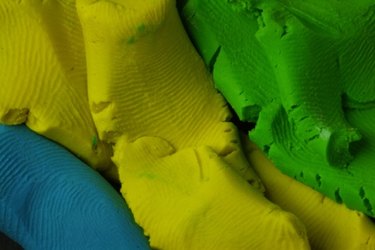Things You'll Need
Two old metal cooking pots (not to be used for food)
Water
Stove
Beeswax
Measuring cup
Limestone powder
Measuring spoons
Mineral oil
Coconut oil or linseed oil
Petroleum jelly
Heatproof trays or molds

Although Plasticine is used as an umbrella term for reusable modeling clays in general, it's actually a registered trademark relating to a particular kind of reusable oil clay. The original Plasticine was developed by art teacher William Harbutt in 1897; Harbutt wanted a clay that would not dry out so that his students could correct their sculptures. The exact recipe of Plasticine is a trade secret but oil clays with approximately similar properties can be made by mixing powdered clay, talc, limestone or other minerals with oils or petroleum jelly.
Step 1
Add water to the larger pot. Place the smaller pot inside the larger pot to make a double boiler. Place the pots on the stove. Bring the water to a boil.
Video of the Day
Step 2
Break the beeswax into pieces. Place in the small pot. Melt the beeswax at a medium heat. When the beeswax has melted completely, measure in 3/4 cup of the limestone powder and stir into the beeswax. Stir until the mixture is smooth and free of lumps.
Step 3
Add 6 tsp. of mineral oil, 2 tbsp. of coconut oil or linseed oil and 3 tbsp. of petroleum jelly to the mixture. Stir for 30 seconds, mixing thoroughly. Remove the mixture from the heat.
Step 4
Pour the mixture into the molds. Allow to harden. Test the consistency of the clay by breaking off a piece and rolling it in your hands. If it is too soft or too hard, return the clay to the double boiler and melt it again. Add a little more limestone powder if the clay is too soft; add a little more oil if the clay is too hard.
Tip
You can color the oil clay by adding powdered pigment to the mixture while it is still melted.
Warning
Always use a double boiler to melt the wax and oil. Don't allow the mixture to overheat. Do not use the utensils used to make the oil clay for food.
Video of the Day